FIN4212: Evaluating the Use of OPR and SRR for Economic Goals
VerifiedAdded on 2022/08/13
|12
|3502
|20
Essay
AI Summary
This essay analyzes the role of the Overnight Policy Rate (OPR) and Statutory Reserve Requirement (SRR) in achieving economic goals, particularly within the Malaysian context. It examines the impact of reducing the SRR on money supply, demand, and supply dynamics, as well as its effects on government deficits. The paper discusses how OPR influences interest rates, consumer spending, and investment, while also exploring the relationship between SRR, bank liquidity, and financial stability. The analysis includes the tools of economic analysis to financial issues, and evaluates the use of monetary policy in addressing economic challenges, such as the impact of trade tensions and global uncertainties on Malaysia's economic growth. The essay also discusses the effects of OPR and SRR on government deficit and the overall performance of banks. It concludes by highlighting the effectiveness of these tools in achieving economic objectives and maintaining financial stability. The essay aims to provide insights into how these monetary policy instruments can be used to manage the economy and achieve sustainable growth.
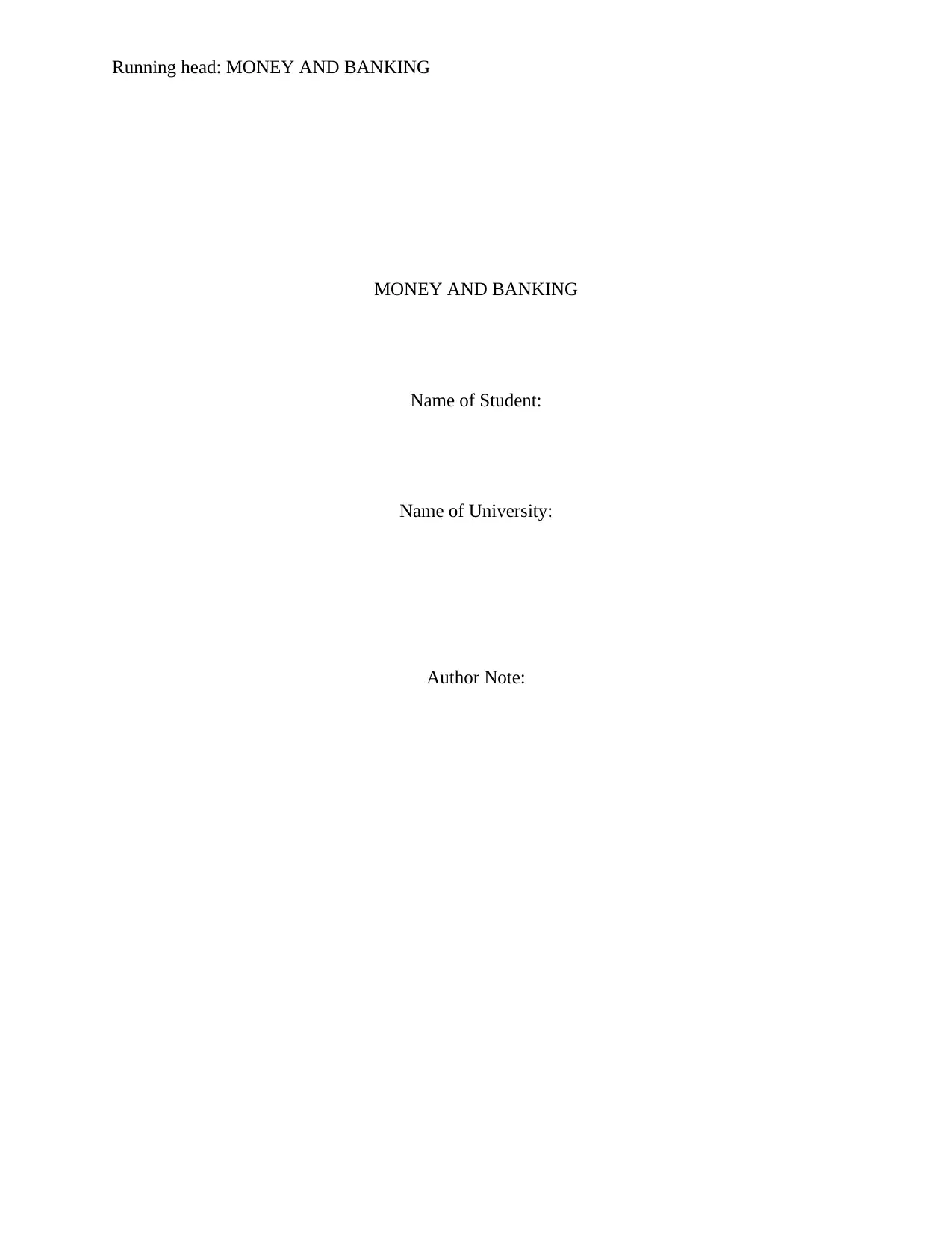
Running head: MONEY AND BANKING
MONEY AND BANKING
Name of Student:
Name of University:
Author Note:
MONEY AND BANKING
Name of Student:
Name of University:
Author Note:
Paraphrase This Document
Need a fresh take? Get an instant paraphrase of this document with our AI Paraphraser
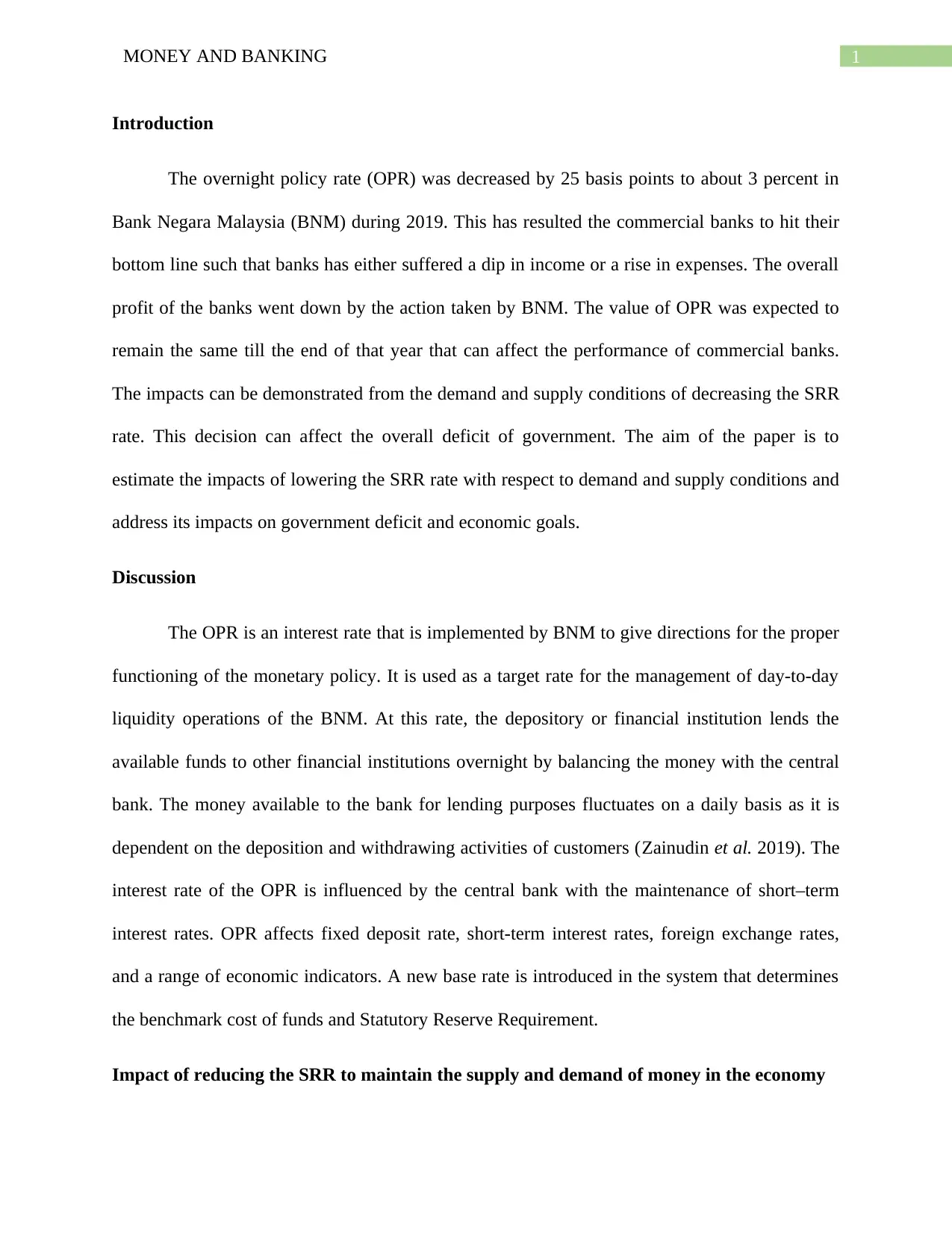
1MONEY AND BANKING
Introduction
The overnight policy rate (OPR) was decreased by 25 basis points to about 3 percent in
Bank Negara Malaysia (BNM) during 2019. This has resulted the commercial banks to hit their
bottom line such that banks has either suffered a dip in income or a rise in expenses. The overall
profit of the banks went down by the action taken by BNM. The value of OPR was expected to
remain the same till the end of that year that can affect the performance of commercial banks.
The impacts can be demonstrated from the demand and supply conditions of decreasing the SRR
rate. This decision can affect the overall deficit of government. The aim of the paper is to
estimate the impacts of lowering the SRR rate with respect to demand and supply conditions and
address its impacts on government deficit and economic goals.
Discussion
The OPR is an interest rate that is implemented by BNM to give directions for the proper
functioning of the monetary policy. It is used as a target rate for the management of day-to-day
liquidity operations of the BNM. At this rate, the depository or financial institution lends the
available funds to other financial institutions overnight by balancing the money with the central
bank. The money available to the bank for lending purposes fluctuates on a daily basis as it is
dependent on the deposition and withdrawing activities of customers (Zainudin et al. 2019). The
interest rate of the OPR is influenced by the central bank with the maintenance of short–term
interest rates. OPR affects fixed deposit rate, short-term interest rates, foreign exchange rates,
and a range of economic indicators. A new base rate is introduced in the system that determines
the benchmark cost of funds and Statutory Reserve Requirement.
Impact of reducing the SRR to maintain the supply and demand of money in the economy
Introduction
The overnight policy rate (OPR) was decreased by 25 basis points to about 3 percent in
Bank Negara Malaysia (BNM) during 2019. This has resulted the commercial banks to hit their
bottom line such that banks has either suffered a dip in income or a rise in expenses. The overall
profit of the banks went down by the action taken by BNM. The value of OPR was expected to
remain the same till the end of that year that can affect the performance of commercial banks.
The impacts can be demonstrated from the demand and supply conditions of decreasing the SRR
rate. This decision can affect the overall deficit of government. The aim of the paper is to
estimate the impacts of lowering the SRR rate with respect to demand and supply conditions and
address its impacts on government deficit and economic goals.
Discussion
The OPR is an interest rate that is implemented by BNM to give directions for the proper
functioning of the monetary policy. It is used as a target rate for the management of day-to-day
liquidity operations of the BNM. At this rate, the depository or financial institution lends the
available funds to other financial institutions overnight by balancing the money with the central
bank. The money available to the bank for lending purposes fluctuates on a daily basis as it is
dependent on the deposition and withdrawing activities of customers (Zainudin et al. 2019). The
interest rate of the OPR is influenced by the central bank with the maintenance of short–term
interest rates. OPR affects fixed deposit rate, short-term interest rates, foreign exchange rates,
and a range of economic indicators. A new base rate is introduced in the system that determines
the benchmark cost of funds and Statutory Reserve Requirement.
Impact of reducing the SRR to maintain the supply and demand of money in the economy
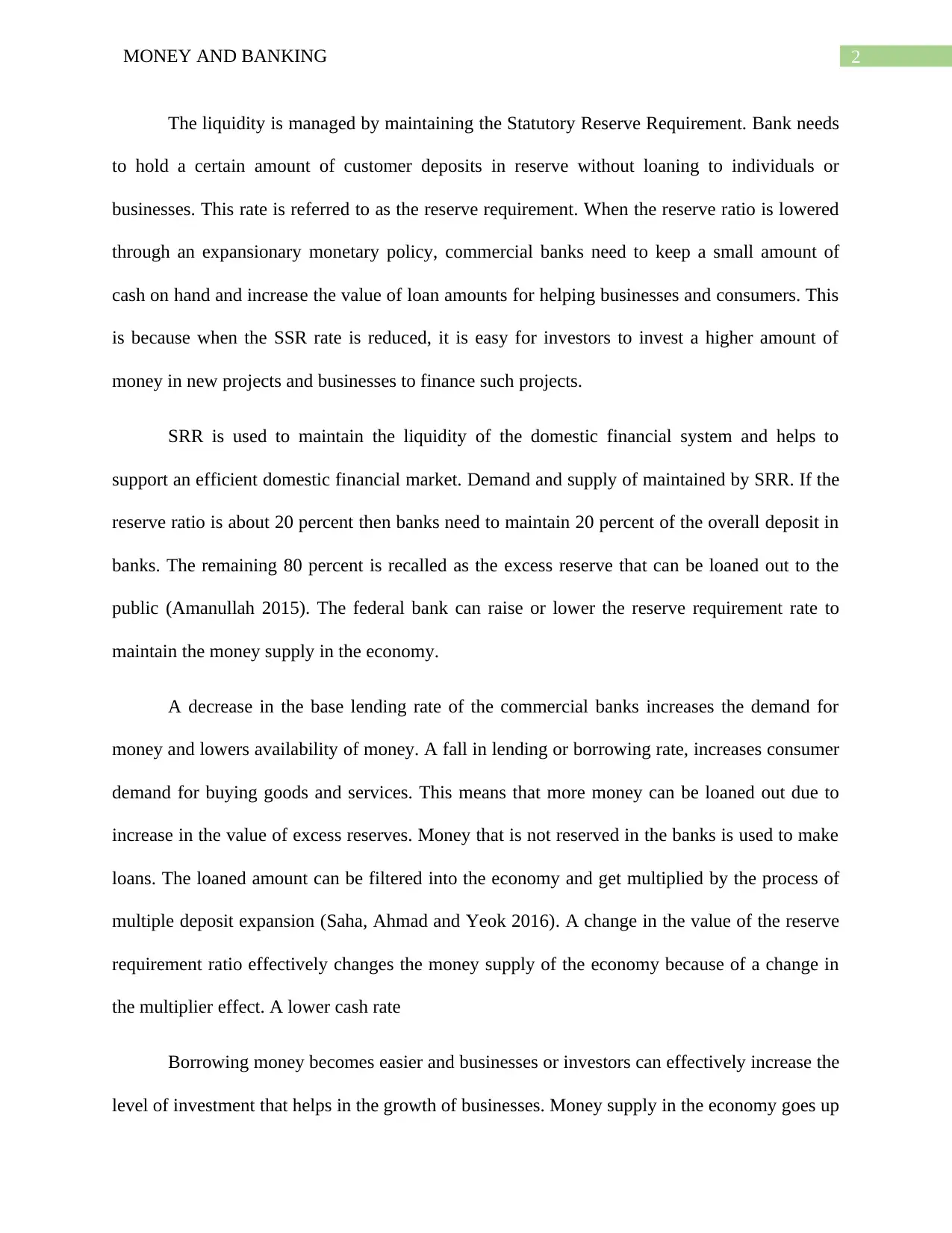
2MONEY AND BANKING
The liquidity is managed by maintaining the Statutory Reserve Requirement. Bank needs
to hold a certain amount of customer deposits in reserve without loaning to individuals or
businesses. This rate is referred to as the reserve requirement. When the reserve ratio is lowered
through an expansionary monetary policy, commercial banks need to keep a small amount of
cash on hand and increase the value of loan amounts for helping businesses and consumers. This
is because when the SSR rate is reduced, it is easy for investors to invest a higher amount of
money in new projects and businesses to finance such projects.
SRR is used to maintain the liquidity of the domestic financial system and helps to
support an efficient domestic financial market. Demand and supply of maintained by SRR. If the
reserve ratio is about 20 percent then banks need to maintain 20 percent of the overall deposit in
banks. The remaining 80 percent is recalled as the excess reserve that can be loaned out to the
public (Amanullah 2015). The federal bank can raise or lower the reserve requirement rate to
maintain the money supply in the economy.
A decrease in the base lending rate of the commercial banks increases the demand for
money and lowers availability of money. A fall in lending or borrowing rate, increases consumer
demand for buying goods and services. This means that more money can be loaned out due to
increase in the value of excess reserves. Money that is not reserved in the banks is used to make
loans. The loaned amount can be filtered into the economy and get multiplied by the process of
multiple deposit expansion (Saha, Ahmad and Yeok 2016). A change in the value of the reserve
requirement ratio effectively changes the money supply of the economy because of a change in
the multiplier effect. A lower cash rate
Borrowing money becomes easier and businesses or investors can effectively increase the
level of investment that helps in the growth of businesses. Money supply in the economy goes up
The liquidity is managed by maintaining the Statutory Reserve Requirement. Bank needs
to hold a certain amount of customer deposits in reserve without loaning to individuals or
businesses. This rate is referred to as the reserve requirement. When the reserve ratio is lowered
through an expansionary monetary policy, commercial banks need to keep a small amount of
cash on hand and increase the value of loan amounts for helping businesses and consumers. This
is because when the SSR rate is reduced, it is easy for investors to invest a higher amount of
money in new projects and businesses to finance such projects.
SRR is used to maintain the liquidity of the domestic financial system and helps to
support an efficient domestic financial market. Demand and supply of maintained by SRR. If the
reserve ratio is about 20 percent then banks need to maintain 20 percent of the overall deposit in
banks. The remaining 80 percent is recalled as the excess reserve that can be loaned out to the
public (Amanullah 2015). The federal bank can raise or lower the reserve requirement rate to
maintain the money supply in the economy.
A decrease in the base lending rate of the commercial banks increases the demand for
money and lowers availability of money. A fall in lending or borrowing rate, increases consumer
demand for buying goods and services. This means that more money can be loaned out due to
increase in the value of excess reserves. Money that is not reserved in the banks is used to make
loans. The loaned amount can be filtered into the economy and get multiplied by the process of
multiple deposit expansion (Saha, Ahmad and Yeok 2016). A change in the value of the reserve
requirement ratio effectively changes the money supply of the economy because of a change in
the multiplier effect. A lower cash rate
Borrowing money becomes easier and businesses or investors can effectively increase the
level of investment that helps in the growth of businesses. Money supply in the economy goes up
⊘ This is a preview!⊘
Do you want full access?
Subscribe today to unlock all pages.

Trusted by 1+ million students worldwide
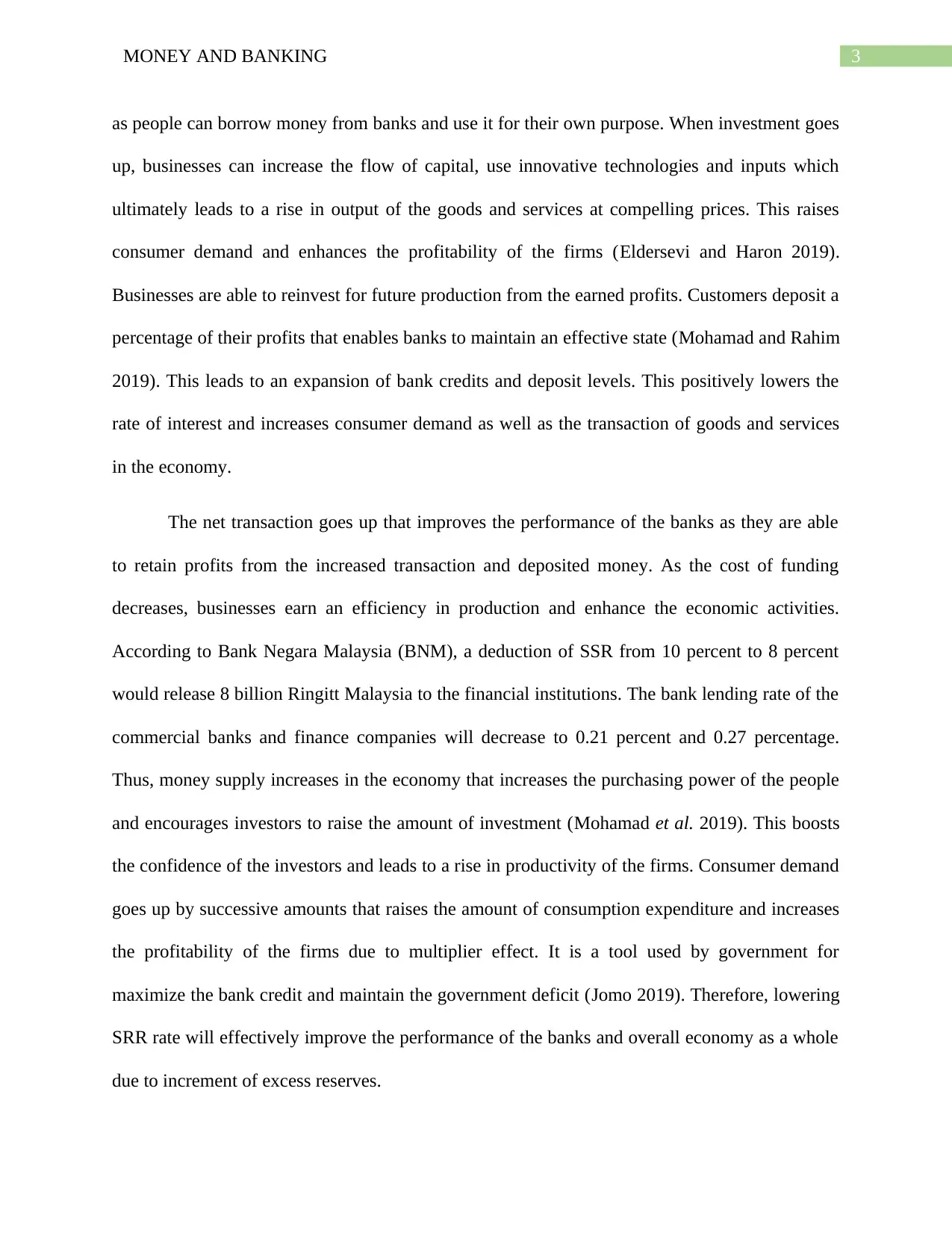
3MONEY AND BANKING
as people can borrow money from banks and use it for their own purpose. When investment goes
up, businesses can increase the flow of capital, use innovative technologies and inputs which
ultimately leads to a rise in output of the goods and services at compelling prices. This raises
consumer demand and enhances the profitability of the firms (Eldersevi and Haron 2019).
Businesses are able to reinvest for future production from the earned profits. Customers deposit a
percentage of their profits that enables banks to maintain an effective state (Mohamad and Rahim
2019). This leads to an expansion of bank credits and deposit levels. This positively lowers the
rate of interest and increases consumer demand as well as the transaction of goods and services
in the economy.
The net transaction goes up that improves the performance of the banks as they are able
to retain profits from the increased transaction and deposited money. As the cost of funding
decreases, businesses earn an efficiency in production and enhance the economic activities.
According to Bank Negara Malaysia (BNM), a deduction of SSR from 10 percent to 8 percent
would release 8 billion Ringitt Malaysia to the financial institutions. The bank lending rate of the
commercial banks and finance companies will decrease to 0.21 percent and 0.27 percentage.
Thus, money supply increases in the economy that increases the purchasing power of the people
and encourages investors to raise the amount of investment (Mohamad et al. 2019). This boosts
the confidence of the investors and leads to a rise in productivity of the firms. Consumer demand
goes up by successive amounts that raises the amount of consumption expenditure and increases
the profitability of the firms due to multiplier effect. It is a tool used by government for
maximize the bank credit and maintain the government deficit (Jomo 2019). Therefore, lowering
SRR rate will effectively improve the performance of the banks and overall economy as a whole
due to increment of excess reserves.
as people can borrow money from banks and use it for their own purpose. When investment goes
up, businesses can increase the flow of capital, use innovative technologies and inputs which
ultimately leads to a rise in output of the goods and services at compelling prices. This raises
consumer demand and enhances the profitability of the firms (Eldersevi and Haron 2019).
Businesses are able to reinvest for future production from the earned profits. Customers deposit a
percentage of their profits that enables banks to maintain an effective state (Mohamad and Rahim
2019). This leads to an expansion of bank credits and deposit levels. This positively lowers the
rate of interest and increases consumer demand as well as the transaction of goods and services
in the economy.
The net transaction goes up that improves the performance of the banks as they are able
to retain profits from the increased transaction and deposited money. As the cost of funding
decreases, businesses earn an efficiency in production and enhance the economic activities.
According to Bank Negara Malaysia (BNM), a deduction of SSR from 10 percent to 8 percent
would release 8 billion Ringitt Malaysia to the financial institutions. The bank lending rate of the
commercial banks and finance companies will decrease to 0.21 percent and 0.27 percentage.
Thus, money supply increases in the economy that increases the purchasing power of the people
and encourages investors to raise the amount of investment (Mohamad et al. 2019). This boosts
the confidence of the investors and leads to a rise in productivity of the firms. Consumer demand
goes up by successive amounts that raises the amount of consumption expenditure and increases
the profitability of the firms due to multiplier effect. It is a tool used by government for
maximize the bank credit and maintain the government deficit (Jomo 2019). Therefore, lowering
SRR rate will effectively improve the performance of the banks and overall economy as a whole
due to increment of excess reserves.
Paraphrase This Document
Need a fresh take? Get an instant paraphrase of this document with our AI Paraphraser
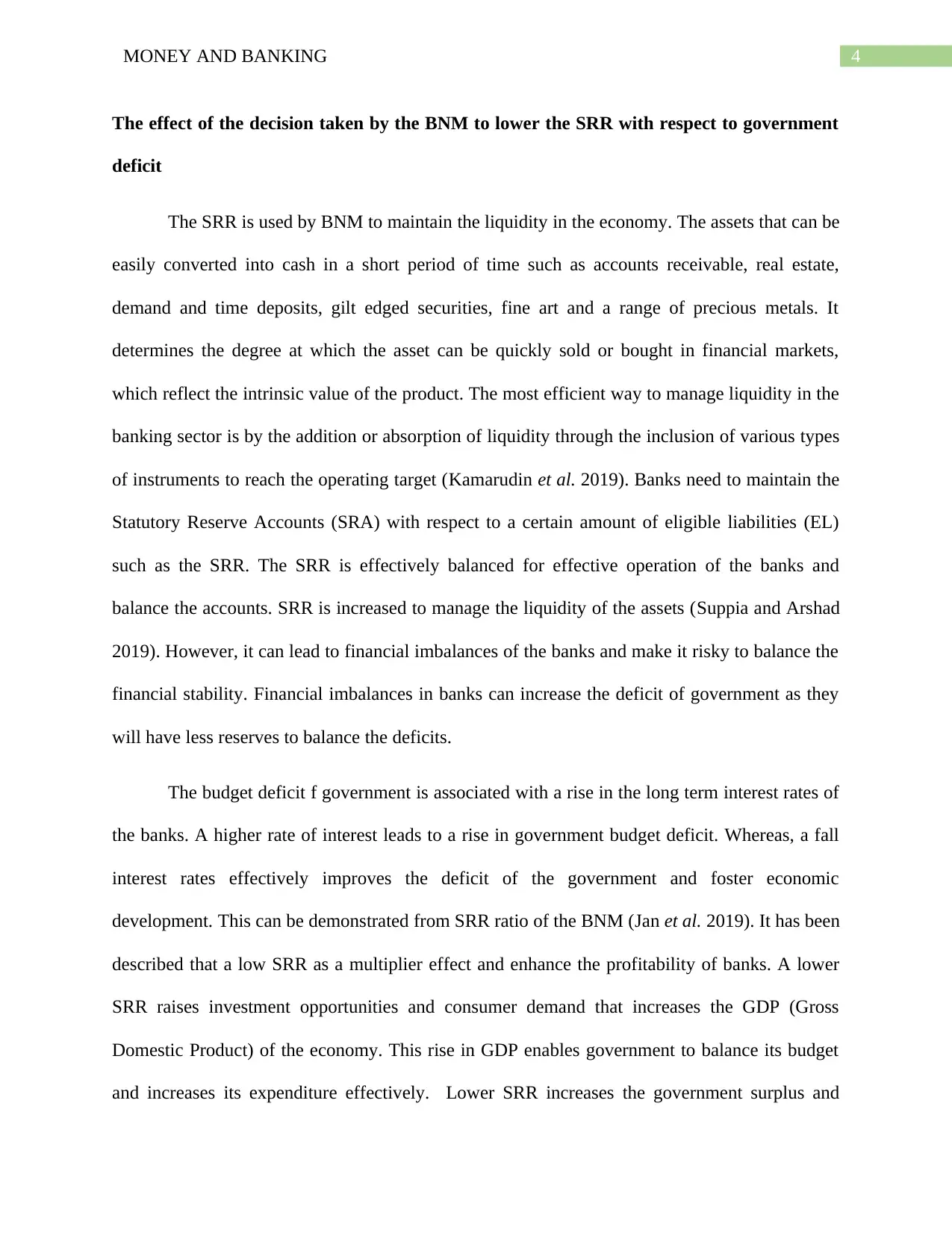
4MONEY AND BANKING
The effect of the decision taken by the BNM to lower the SRR with respect to government
deficit
The SRR is used by BNM to maintain the liquidity in the economy. The assets that can be
easily converted into cash in a short period of time such as accounts receivable, real estate,
demand and time deposits, gilt edged securities, fine art and a range of precious metals. It
determines the degree at which the asset can be quickly sold or bought in financial markets,
which reflect the intrinsic value of the product. The most efficient way to manage liquidity in the
banking sector is by the addition or absorption of liquidity through the inclusion of various types
of instruments to reach the operating target (Kamarudin et al. 2019). Banks need to maintain the
Statutory Reserve Accounts (SRA) with respect to a certain amount of eligible liabilities (EL)
such as the SRR. The SRR is effectively balanced for effective operation of the banks and
balance the accounts. SRR is increased to manage the liquidity of the assets (Suppia and Arshad
2019). However, it can lead to financial imbalances of the banks and make it risky to balance the
financial stability. Financial imbalances in banks can increase the deficit of government as they
will have less reserves to balance the deficits.
The budget deficit f government is associated with a rise in the long term interest rates of
the banks. A higher rate of interest leads to a rise in government budget deficit. Whereas, a fall
interest rates effectively improves the deficit of the government and foster economic
development. This can be demonstrated from SRR ratio of the BNM (Jan et al. 2019). It has been
described that a low SRR as a multiplier effect and enhance the profitability of banks. A lower
SRR raises investment opportunities and consumer demand that increases the GDP (Gross
Domestic Product) of the economy. This rise in GDP enables government to balance its budget
and increases its expenditure effectively. Lower SRR increases the government surplus and
The effect of the decision taken by the BNM to lower the SRR with respect to government
deficit
The SRR is used by BNM to maintain the liquidity in the economy. The assets that can be
easily converted into cash in a short period of time such as accounts receivable, real estate,
demand and time deposits, gilt edged securities, fine art and a range of precious metals. It
determines the degree at which the asset can be quickly sold or bought in financial markets,
which reflect the intrinsic value of the product. The most efficient way to manage liquidity in the
banking sector is by the addition or absorption of liquidity through the inclusion of various types
of instruments to reach the operating target (Kamarudin et al. 2019). Banks need to maintain the
Statutory Reserve Accounts (SRA) with respect to a certain amount of eligible liabilities (EL)
such as the SRR. The SRR is effectively balanced for effective operation of the banks and
balance the accounts. SRR is increased to manage the liquidity of the assets (Suppia and Arshad
2019). However, it can lead to financial imbalances of the banks and make it risky to balance the
financial stability. Financial imbalances in banks can increase the deficit of government as they
will have less reserves to balance the deficits.
The budget deficit f government is associated with a rise in the long term interest rates of
the banks. A higher rate of interest leads to a rise in government budget deficit. Whereas, a fall
interest rates effectively improves the deficit of the government and foster economic
development. This can be demonstrated from SRR ratio of the BNM (Jan et al. 2019). It has been
described that a low SRR as a multiplier effect and enhance the profitability of banks. A lower
SRR raises investment opportunities and consumer demand that increases the GDP (Gross
Domestic Product) of the economy. This rise in GDP enables government to balance its budget
and increases its expenditure effectively. Lower SRR increases the government surplus and
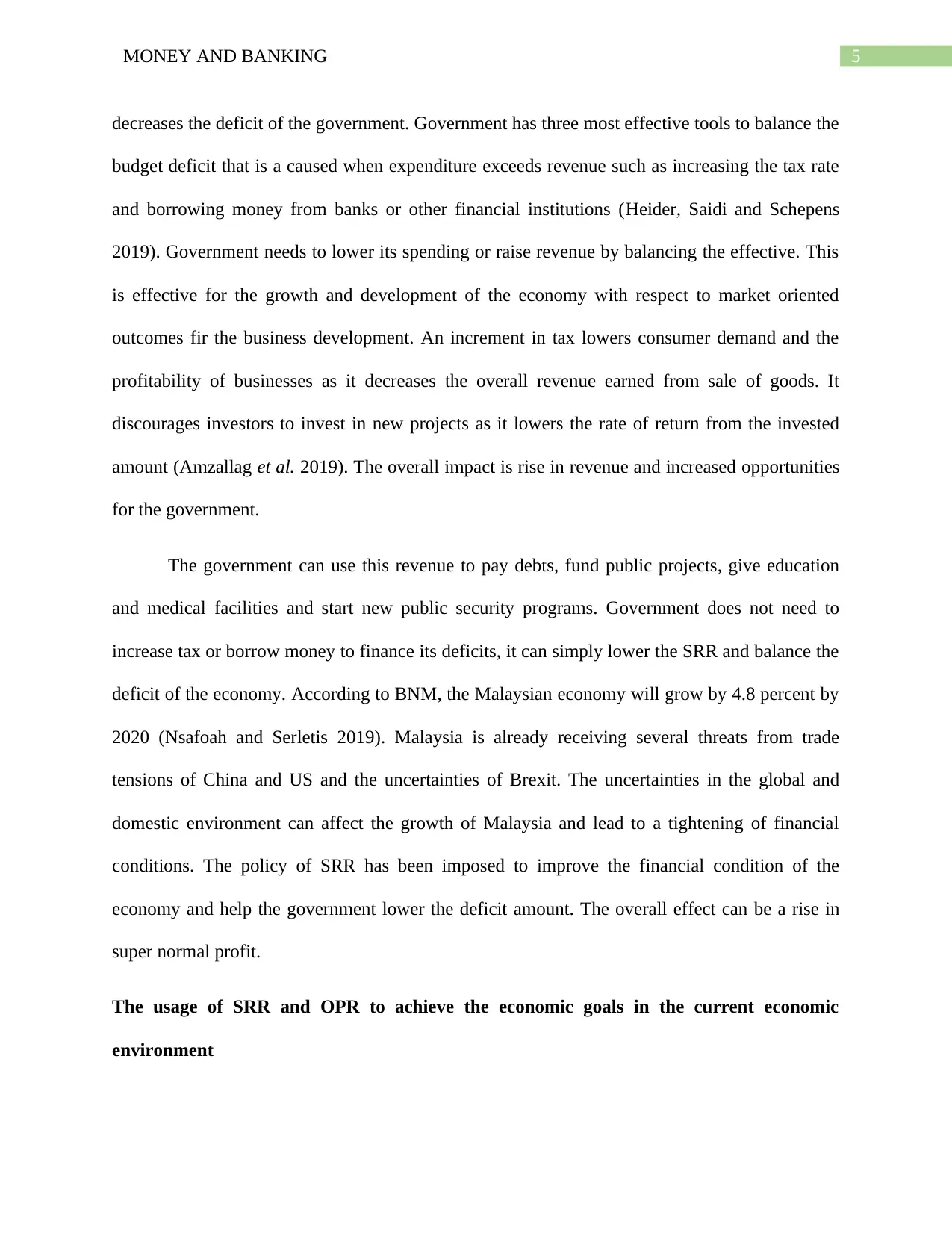
5MONEY AND BANKING
decreases the deficit of the government. Government has three most effective tools to balance the
budget deficit that is a caused when expenditure exceeds revenue such as increasing the tax rate
and borrowing money from banks or other financial institutions (Heider, Saidi and Schepens
2019). Government needs to lower its spending or raise revenue by balancing the effective. This
is effective for the growth and development of the economy with respect to market oriented
outcomes fir the business development. An increment in tax lowers consumer demand and the
profitability of businesses as it decreases the overall revenue earned from sale of goods. It
discourages investors to invest in new projects as it lowers the rate of return from the invested
amount (Amzallag et al. 2019). The overall impact is rise in revenue and increased opportunities
for the government.
The government can use this revenue to pay debts, fund public projects, give education
and medical facilities and start new public security programs. Government does not need to
increase tax or borrow money to finance its deficits, it can simply lower the SRR and balance the
deficit of the economy. According to BNM, the Malaysian economy will grow by 4.8 percent by
2020 (Nsafoah and Serletis 2019). Malaysia is already receiving several threats from trade
tensions of China and US and the uncertainties of Brexit. The uncertainties in the global and
domestic environment can affect the growth of Malaysia and lead to a tightening of financial
conditions. The policy of SRR has been imposed to improve the financial condition of the
economy and help the government lower the deficit amount. The overall effect can be a rise in
super normal profit.
The usage of SRR and OPR to achieve the economic goals in the current economic
environment
decreases the deficit of the government. Government has three most effective tools to balance the
budget deficit that is a caused when expenditure exceeds revenue such as increasing the tax rate
and borrowing money from banks or other financial institutions (Heider, Saidi and Schepens
2019). Government needs to lower its spending or raise revenue by balancing the effective. This
is effective for the growth and development of the economy with respect to market oriented
outcomes fir the business development. An increment in tax lowers consumer demand and the
profitability of businesses as it decreases the overall revenue earned from sale of goods. It
discourages investors to invest in new projects as it lowers the rate of return from the invested
amount (Amzallag et al. 2019). The overall impact is rise in revenue and increased opportunities
for the government.
The government can use this revenue to pay debts, fund public projects, give education
and medical facilities and start new public security programs. Government does not need to
increase tax or borrow money to finance its deficits, it can simply lower the SRR and balance the
deficit of the economy. According to BNM, the Malaysian economy will grow by 4.8 percent by
2020 (Nsafoah and Serletis 2019). Malaysia is already receiving several threats from trade
tensions of China and US and the uncertainties of Brexit. The uncertainties in the global and
domestic environment can affect the growth of Malaysia and lead to a tightening of financial
conditions. The policy of SRR has been imposed to improve the financial condition of the
economy and help the government lower the deficit amount. The overall effect can be a rise in
super normal profit.
The usage of SRR and OPR to achieve the economic goals in the current economic
environment
⊘ This is a preview!⊘
Do you want full access?
Subscribe today to unlock all pages.

Trusted by 1+ million students worldwide
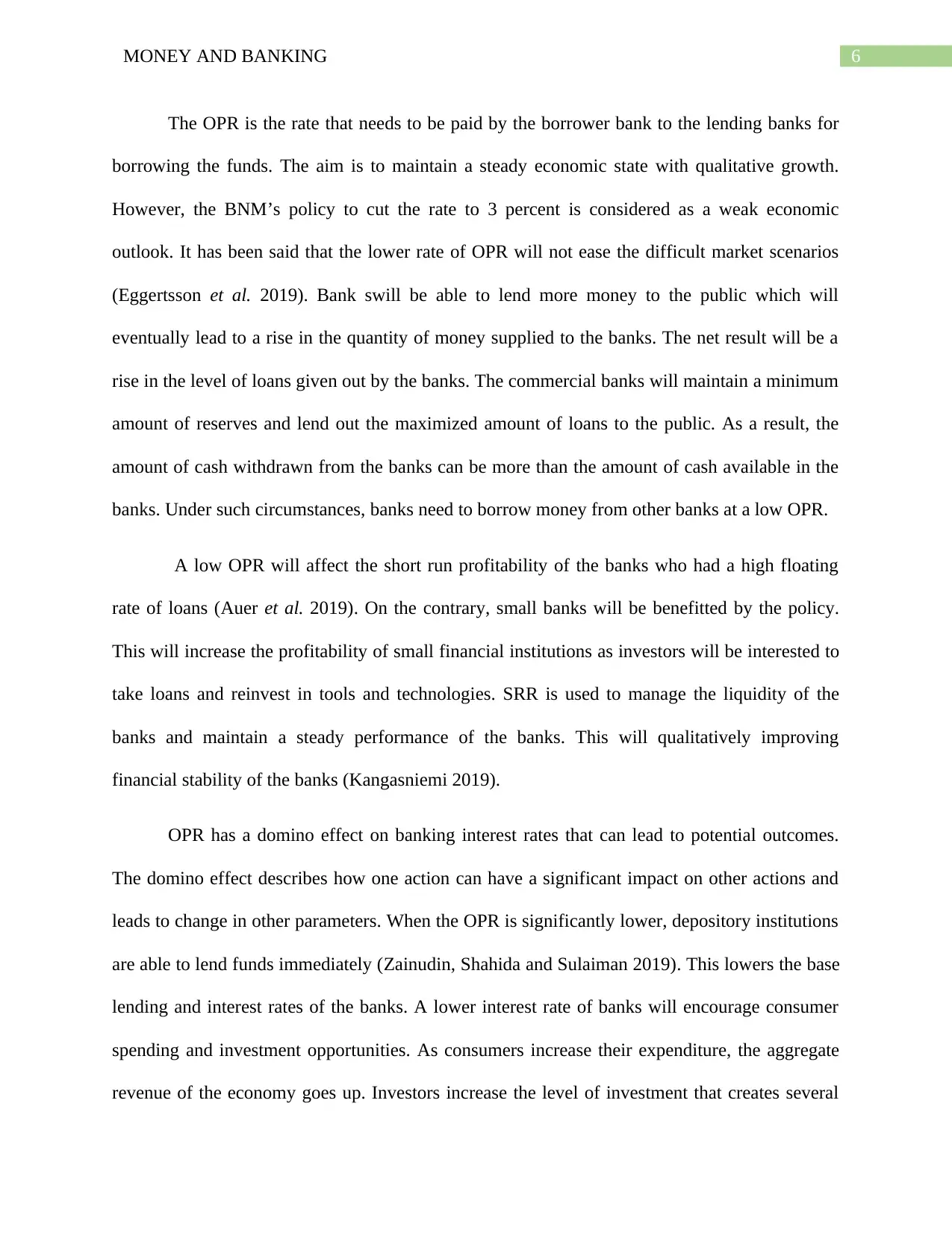
6MONEY AND BANKING
The OPR is the rate that needs to be paid by the borrower bank to the lending banks for
borrowing the funds. The aim is to maintain a steady economic state with qualitative growth.
However, the BNM’s policy to cut the rate to 3 percent is considered as a weak economic
outlook. It has been said that the lower rate of OPR will not ease the difficult market scenarios
(Eggertsson et al. 2019). Bank swill be able to lend more money to the public which will
eventually lead to a rise in the quantity of money supplied to the banks. The net result will be a
rise in the level of loans given out by the banks. The commercial banks will maintain a minimum
amount of reserves and lend out the maximized amount of loans to the public. As a result, the
amount of cash withdrawn from the banks can be more than the amount of cash available in the
banks. Under such circumstances, banks need to borrow money from other banks at a low OPR.
A low OPR will affect the short run profitability of the banks who had a high floating
rate of loans (Auer et al. 2019). On the contrary, small banks will be benefitted by the policy.
This will increase the profitability of small financial institutions as investors will be interested to
take loans and reinvest in tools and technologies. SRR is used to manage the liquidity of the
banks and maintain a steady performance of the banks. This will qualitatively improving
financial stability of the banks (Kangasniemi 2019).
OPR has a domino effect on banking interest rates that can lead to potential outcomes.
The domino effect describes how one action can have a significant impact on other actions and
leads to change in other parameters. When the OPR is significantly lower, depository institutions
are able to lend funds immediately (Zainudin, Shahida and Sulaiman 2019). This lowers the base
lending and interest rates of the banks. A lower interest rate of banks will encourage consumer
spending and investment opportunities. As consumers increase their expenditure, the aggregate
revenue of the economy goes up. Investors increase the level of investment that creates several
The OPR is the rate that needs to be paid by the borrower bank to the lending banks for
borrowing the funds. The aim is to maintain a steady economic state with qualitative growth.
However, the BNM’s policy to cut the rate to 3 percent is considered as a weak economic
outlook. It has been said that the lower rate of OPR will not ease the difficult market scenarios
(Eggertsson et al. 2019). Bank swill be able to lend more money to the public which will
eventually lead to a rise in the quantity of money supplied to the banks. The net result will be a
rise in the level of loans given out by the banks. The commercial banks will maintain a minimum
amount of reserves and lend out the maximized amount of loans to the public. As a result, the
amount of cash withdrawn from the banks can be more than the amount of cash available in the
banks. Under such circumstances, banks need to borrow money from other banks at a low OPR.
A low OPR will affect the short run profitability of the banks who had a high floating
rate of loans (Auer et al. 2019). On the contrary, small banks will be benefitted by the policy.
This will increase the profitability of small financial institutions as investors will be interested to
take loans and reinvest in tools and technologies. SRR is used to manage the liquidity of the
banks and maintain a steady performance of the banks. This will qualitatively improving
financial stability of the banks (Kangasniemi 2019).
OPR has a domino effect on banking interest rates that can lead to potential outcomes.
The domino effect describes how one action can have a significant impact on other actions and
leads to change in other parameters. When the OPR is significantly lower, depository institutions
are able to lend funds immediately (Zainudin, Shahida and Sulaiman 2019). This lowers the base
lending and interest rates of the banks. A lower interest rate of banks will encourage consumer
spending and investment opportunities. As consumers increase their expenditure, the aggregate
revenue of the economy goes up. Investors increase the level of investment that creates several
Paraphrase This Document
Need a fresh take? Get an instant paraphrase of this document with our AI Paraphraser
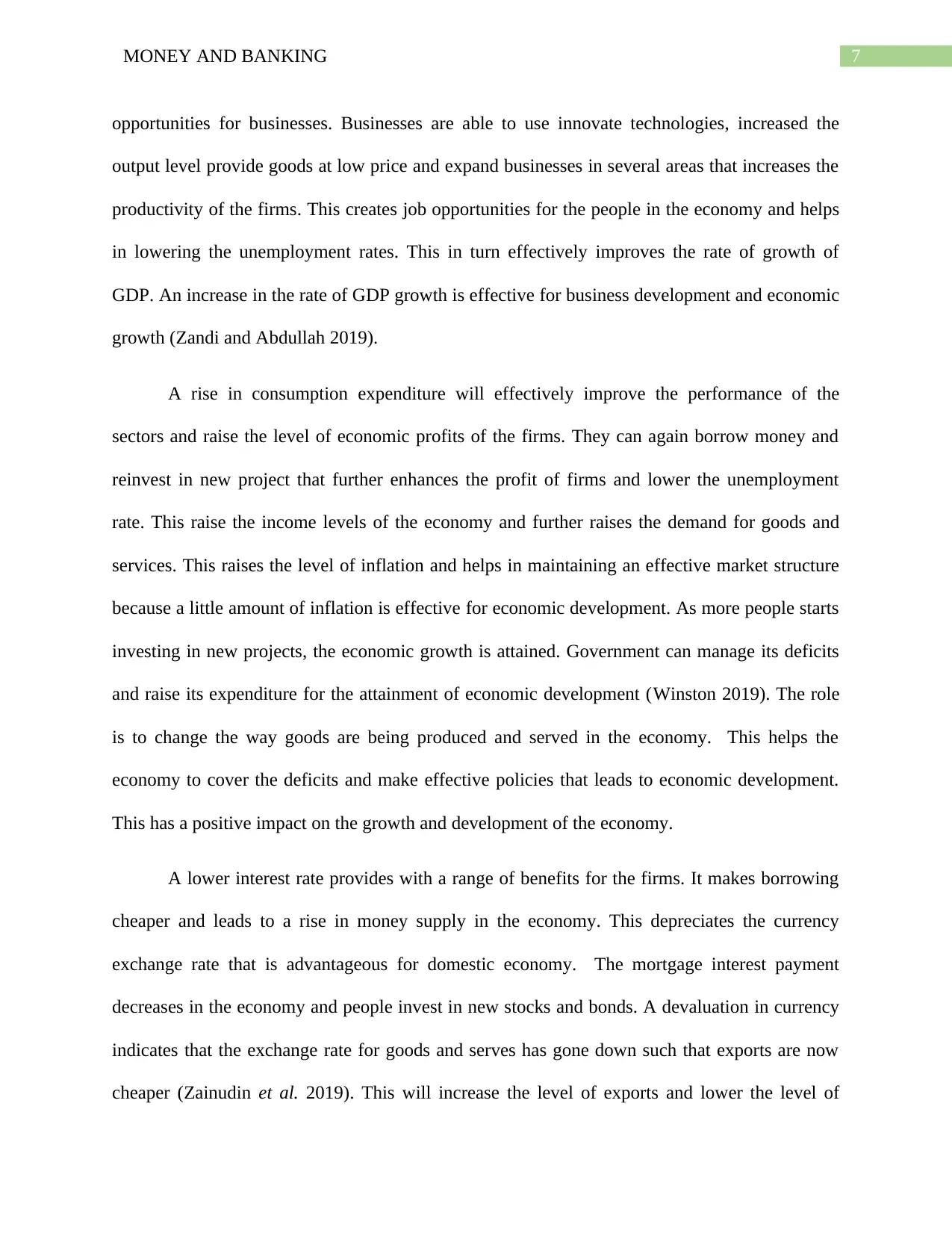
7MONEY AND BANKING
opportunities for businesses. Businesses are able to use innovate technologies, increased the
output level provide goods at low price and expand businesses in several areas that increases the
productivity of the firms. This creates job opportunities for the people in the economy and helps
in lowering the unemployment rates. This in turn effectively improves the rate of growth of
GDP. An increase in the rate of GDP growth is effective for business development and economic
growth (Zandi and Abdullah 2019).
A rise in consumption expenditure will effectively improve the performance of the
sectors and raise the level of economic profits of the firms. They can again borrow money and
reinvest in new project that further enhances the profit of firms and lower the unemployment
rate. This raise the income levels of the economy and further raises the demand for goods and
services. This raises the level of inflation and helps in maintaining an effective market structure
because a little amount of inflation is effective for economic development. As more people starts
investing in new projects, the economic growth is attained. Government can manage its deficits
and raise its expenditure for the attainment of economic development (Winston 2019). The role
is to change the way goods are being produced and served in the economy. This helps the
economy to cover the deficits and make effective policies that leads to economic development.
This has a positive impact on the growth and development of the economy.
A lower interest rate provides with a range of benefits for the firms. It makes borrowing
cheaper and leads to a rise in money supply in the economy. This depreciates the currency
exchange rate that is advantageous for domestic economy. The mortgage interest payment
decreases in the economy and people invest in new stocks and bonds. A devaluation in currency
indicates that the exchange rate for goods and serves has gone down such that exports are now
cheaper (Zainudin et al. 2019). This will increase the level of exports and lower the level of
opportunities for businesses. Businesses are able to use innovate technologies, increased the
output level provide goods at low price and expand businesses in several areas that increases the
productivity of the firms. This creates job opportunities for the people in the economy and helps
in lowering the unemployment rates. This in turn effectively improves the rate of growth of
GDP. An increase in the rate of GDP growth is effective for business development and economic
growth (Zandi and Abdullah 2019).
A rise in consumption expenditure will effectively improve the performance of the
sectors and raise the level of economic profits of the firms. They can again borrow money and
reinvest in new project that further enhances the profit of firms and lower the unemployment
rate. This raise the income levels of the economy and further raises the demand for goods and
services. This raises the level of inflation and helps in maintaining an effective market structure
because a little amount of inflation is effective for economic development. As more people starts
investing in new projects, the economic growth is attained. Government can manage its deficits
and raise its expenditure for the attainment of economic development (Winston 2019). The role
is to change the way goods are being produced and served in the economy. This helps the
economy to cover the deficits and make effective policies that leads to economic development.
This has a positive impact on the growth and development of the economy.
A lower interest rate provides with a range of benefits for the firms. It makes borrowing
cheaper and leads to a rise in money supply in the economy. This depreciates the currency
exchange rate that is advantageous for domestic economy. The mortgage interest payment
decreases in the economy and people invest in new stocks and bonds. A devaluation in currency
indicates that the exchange rate for goods and serves has gone down such that exports are now
cheaper (Zainudin et al. 2019). This will increase the level of exports and lower the level of
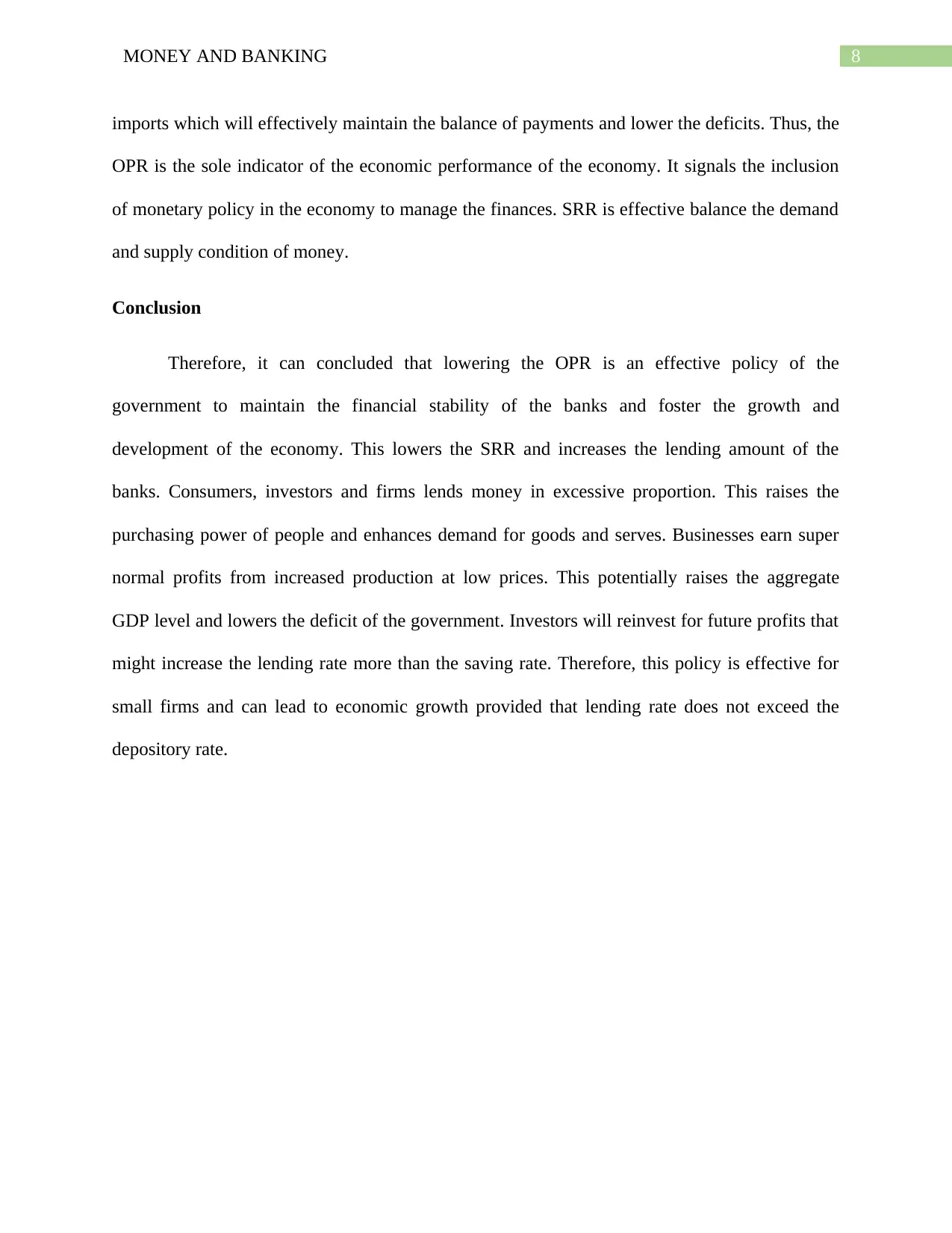
8MONEY AND BANKING
imports which will effectively maintain the balance of payments and lower the deficits. Thus, the
OPR is the sole indicator of the economic performance of the economy. It signals the inclusion
of monetary policy in the economy to manage the finances. SRR is effective balance the demand
and supply condition of money.
Conclusion
Therefore, it can concluded that lowering the OPR is an effective policy of the
government to maintain the financial stability of the banks and foster the growth and
development of the economy. This lowers the SRR and increases the lending amount of the
banks. Consumers, investors and firms lends money in excessive proportion. This raises the
purchasing power of people and enhances demand for goods and serves. Businesses earn super
normal profits from increased production at low prices. This potentially raises the aggregate
GDP level and lowers the deficit of the government. Investors will reinvest for future profits that
might increase the lending rate more than the saving rate. Therefore, this policy is effective for
small firms and can lead to economic growth provided that lending rate does not exceed the
depository rate.
imports which will effectively maintain the balance of payments and lower the deficits. Thus, the
OPR is the sole indicator of the economic performance of the economy. It signals the inclusion
of monetary policy in the economy to manage the finances. SRR is effective balance the demand
and supply condition of money.
Conclusion
Therefore, it can concluded that lowering the OPR is an effective policy of the
government to maintain the financial stability of the banks and foster the growth and
development of the economy. This lowers the SRR and increases the lending amount of the
banks. Consumers, investors and firms lends money in excessive proportion. This raises the
purchasing power of people and enhances demand for goods and serves. Businesses earn super
normal profits from increased production at low prices. This potentially raises the aggregate
GDP level and lowers the deficit of the government. Investors will reinvest for future profits that
might increase the lending rate more than the saving rate. Therefore, this policy is effective for
small firms and can lead to economic growth provided that lending rate does not exceed the
depository rate.
⊘ This is a preview!⊘
Do you want full access?
Subscribe today to unlock all pages.

Trusted by 1+ million students worldwide
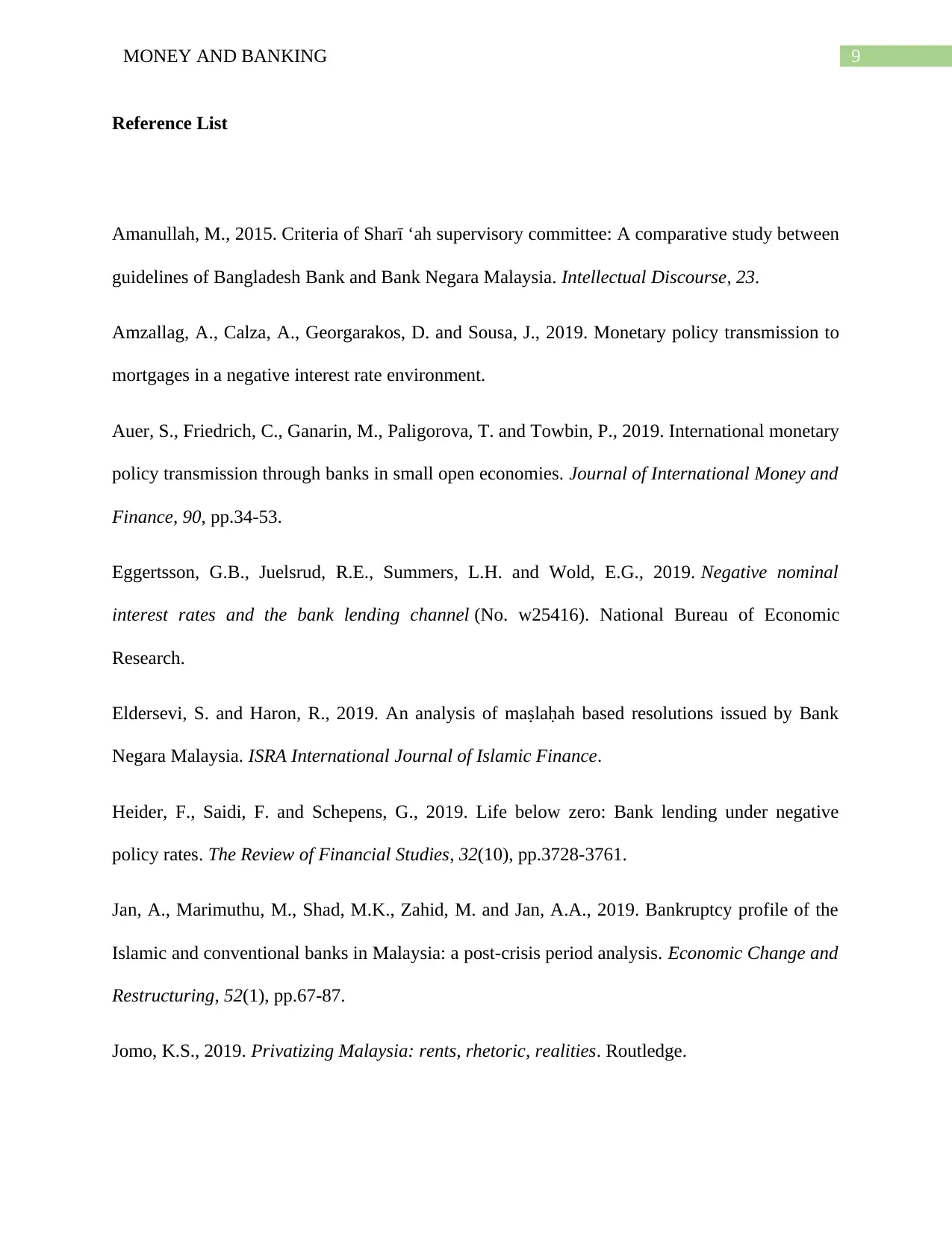
9MONEY AND BANKING
Reference List
Amanullah, M., 2015. Criteria of Sharī ‘ah supervisory committee: A comparative study between
guidelines of Bangladesh Bank and Bank Negara Malaysia. Intellectual Discourse, 23.
Amzallag, A., Calza, A., Georgarakos, D. and Sousa, J., 2019. Monetary policy transmission to
mortgages in a negative interest rate environment.
Auer, S., Friedrich, C., Ganarin, M., Paligorova, T. and Towbin, P., 2019. International monetary
policy transmission through banks in small open economies. Journal of International Money and
Finance, 90, pp.34-53.
Eggertsson, G.B., Juelsrud, R.E., Summers, L.H. and Wold, E.G., 2019. Negative nominal
interest rates and the bank lending channel (No. w25416). National Bureau of Economic
Research.
Eldersevi, S. and Haron, R., 2019. An analysis of maṣlaḥah based resolutions issued by Bank
Negara Malaysia. ISRA International Journal of Islamic Finance.
Heider, F., Saidi, F. and Schepens, G., 2019. Life below zero: Bank lending under negative
policy rates. The Review of Financial Studies, 32(10), pp.3728-3761.
Jan, A., Marimuthu, M., Shad, M.K., Zahid, M. and Jan, A.A., 2019. Bankruptcy profile of the
Islamic and conventional banks in Malaysia: a post-crisis period analysis. Economic Change and
Restructuring, 52(1), pp.67-87.
Jomo, K.S., 2019. Privatizing Malaysia: rents, rhetoric, realities. Routledge.
Reference List
Amanullah, M., 2015. Criteria of Sharī ‘ah supervisory committee: A comparative study between
guidelines of Bangladesh Bank and Bank Negara Malaysia. Intellectual Discourse, 23.
Amzallag, A., Calza, A., Georgarakos, D. and Sousa, J., 2019. Monetary policy transmission to
mortgages in a negative interest rate environment.
Auer, S., Friedrich, C., Ganarin, M., Paligorova, T. and Towbin, P., 2019. International monetary
policy transmission through banks in small open economies. Journal of International Money and
Finance, 90, pp.34-53.
Eggertsson, G.B., Juelsrud, R.E., Summers, L.H. and Wold, E.G., 2019. Negative nominal
interest rates and the bank lending channel (No. w25416). National Bureau of Economic
Research.
Eldersevi, S. and Haron, R., 2019. An analysis of maṣlaḥah based resolutions issued by Bank
Negara Malaysia. ISRA International Journal of Islamic Finance.
Heider, F., Saidi, F. and Schepens, G., 2019. Life below zero: Bank lending under negative
policy rates. The Review of Financial Studies, 32(10), pp.3728-3761.
Jan, A., Marimuthu, M., Shad, M.K., Zahid, M. and Jan, A.A., 2019. Bankruptcy profile of the
Islamic and conventional banks in Malaysia: a post-crisis period analysis. Economic Change and
Restructuring, 52(1), pp.67-87.
Jomo, K.S., 2019. Privatizing Malaysia: rents, rhetoric, realities. Routledge.
Paraphrase This Document
Need a fresh take? Get an instant paraphrase of this document with our AI Paraphraser
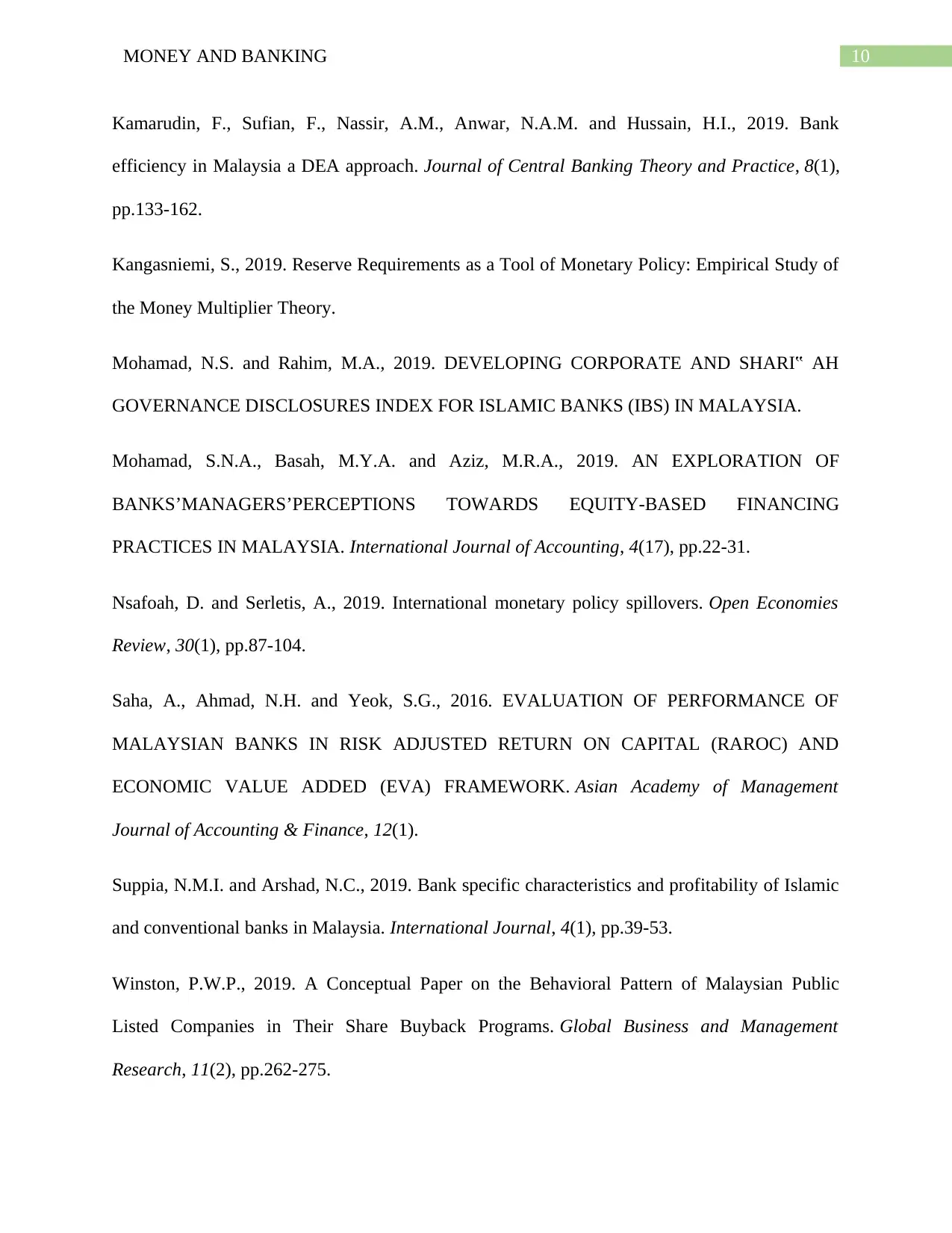
10MONEY AND BANKING
Kamarudin, F., Sufian, F., Nassir, A.M., Anwar, N.A.M. and Hussain, H.I., 2019. Bank
efficiency in Malaysia a DEA approach. Journal of Central Banking Theory and Practice, 8(1),
pp.133-162.
Kangasniemi, S., 2019. Reserve Requirements as a Tool of Monetary Policy: Empirical Study of
the Money Multiplier Theory.
Mohamad, N.S. and Rahim, M.A., 2019. DEVELOPING CORPORATE AND SHARI‟ AH
GOVERNANCE DISCLOSURES INDEX FOR ISLAMIC BANKS (IBS) IN MALAYSIA.
Mohamad, S.N.A., Basah, M.Y.A. and Aziz, M.R.A., 2019. AN EXPLORATION OF
BANKS’MANAGERS’PERCEPTIONS TOWARDS EQUITY-BASED FINANCING
PRACTICES IN MALAYSIA. International Journal of Accounting, 4(17), pp.22-31.
Nsafoah, D. and Serletis, A., 2019. International monetary policy spillovers. Open Economies
Review, 30(1), pp.87-104.
Saha, A., Ahmad, N.H. and Yeok, S.G., 2016. EVALUATION OF PERFORMANCE OF
MALAYSIAN BANKS IN RISK ADJUSTED RETURN ON CAPITAL (RAROC) AND
ECONOMIC VALUE ADDED (EVA) FRAMEWORK. Asian Academy of Management
Journal of Accounting & Finance, 12(1).
Suppia, N.M.I. and Arshad, N.C., 2019. Bank specific characteristics and profitability of Islamic
and conventional banks in Malaysia. International Journal, 4(1), pp.39-53.
Winston, P.W.P., 2019. A Conceptual Paper on the Behavioral Pattern of Malaysian Public
Listed Companies in Their Share Buyback Programs. Global Business and Management
Research, 11(2), pp.262-275.
Kamarudin, F., Sufian, F., Nassir, A.M., Anwar, N.A.M. and Hussain, H.I., 2019. Bank
efficiency in Malaysia a DEA approach. Journal of Central Banking Theory and Practice, 8(1),
pp.133-162.
Kangasniemi, S., 2019. Reserve Requirements as a Tool of Monetary Policy: Empirical Study of
the Money Multiplier Theory.
Mohamad, N.S. and Rahim, M.A., 2019. DEVELOPING CORPORATE AND SHARI‟ AH
GOVERNANCE DISCLOSURES INDEX FOR ISLAMIC BANKS (IBS) IN MALAYSIA.
Mohamad, S.N.A., Basah, M.Y.A. and Aziz, M.R.A., 2019. AN EXPLORATION OF
BANKS’MANAGERS’PERCEPTIONS TOWARDS EQUITY-BASED FINANCING
PRACTICES IN MALAYSIA. International Journal of Accounting, 4(17), pp.22-31.
Nsafoah, D. and Serletis, A., 2019. International monetary policy spillovers. Open Economies
Review, 30(1), pp.87-104.
Saha, A., Ahmad, N.H. and Yeok, S.G., 2016. EVALUATION OF PERFORMANCE OF
MALAYSIAN BANKS IN RISK ADJUSTED RETURN ON CAPITAL (RAROC) AND
ECONOMIC VALUE ADDED (EVA) FRAMEWORK. Asian Academy of Management
Journal of Accounting & Finance, 12(1).
Suppia, N.M.I. and Arshad, N.C., 2019. Bank specific characteristics and profitability of Islamic
and conventional banks in Malaysia. International Journal, 4(1), pp.39-53.
Winston, P.W.P., 2019. A Conceptual Paper on the Behavioral Pattern of Malaysian Public
Listed Companies in Their Share Buyback Programs. Global Business and Management
Research, 11(2), pp.262-275.
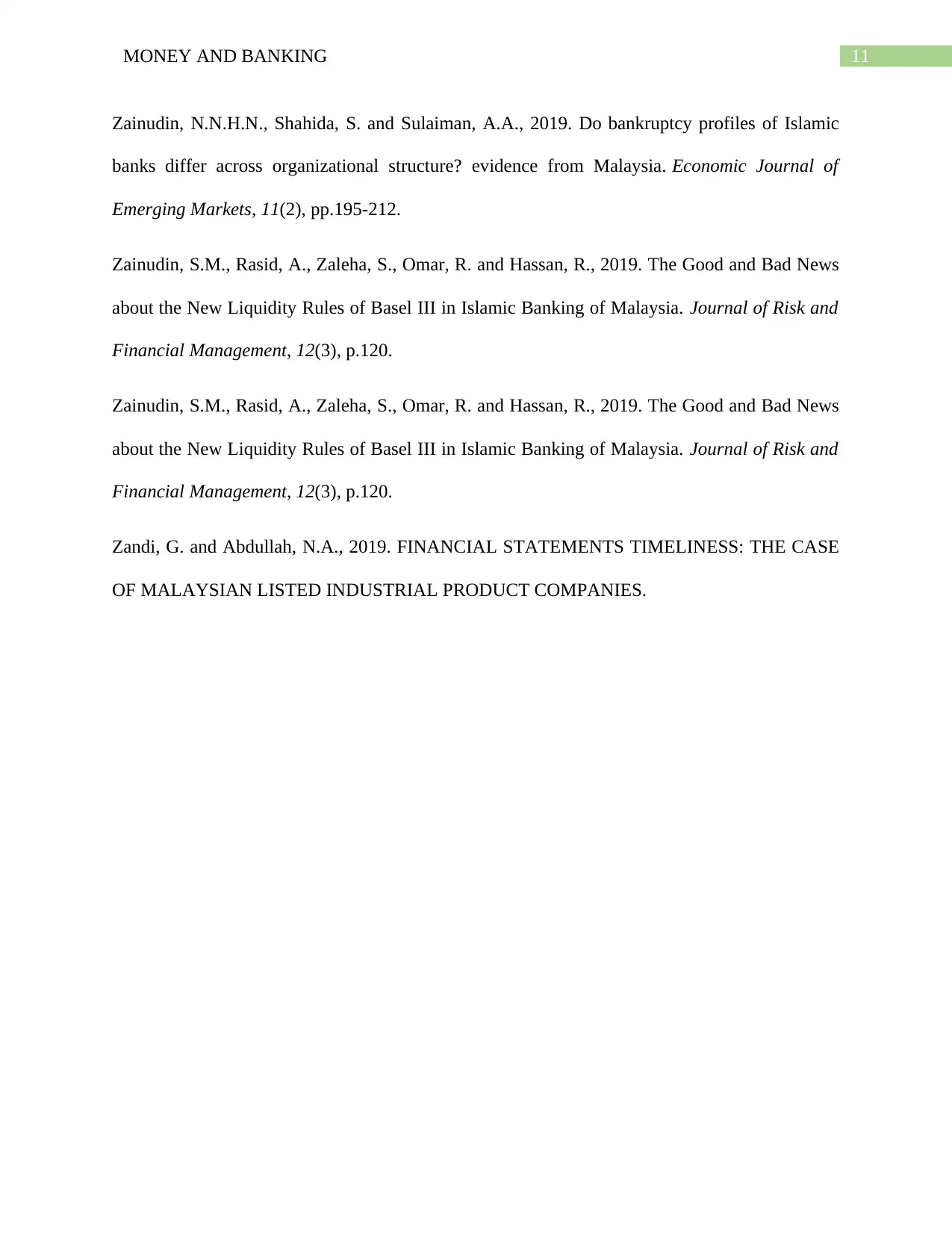
11MONEY AND BANKING
Zainudin, N.N.H.N., Shahida, S. and Sulaiman, A.A., 2019. Do bankruptcy profiles of Islamic
banks differ across organizational structure? evidence from Malaysia. Economic Journal of
Emerging Markets, 11(2), pp.195-212.
Zainudin, S.M., Rasid, A., Zaleha, S., Omar, R. and Hassan, R., 2019. The Good and Bad News
about the New Liquidity Rules of Basel III in Islamic Banking of Malaysia. Journal of Risk and
Financial Management, 12(3), p.120.
Zainudin, S.M., Rasid, A., Zaleha, S., Omar, R. and Hassan, R., 2019. The Good and Bad News
about the New Liquidity Rules of Basel III in Islamic Banking of Malaysia. Journal of Risk and
Financial Management, 12(3), p.120.
Zandi, G. and Abdullah, N.A., 2019. FINANCIAL STATEMENTS TIMELINESS: THE CASE
OF MALAYSIAN LISTED INDUSTRIAL PRODUCT COMPANIES.
Zainudin, N.N.H.N., Shahida, S. and Sulaiman, A.A., 2019. Do bankruptcy profiles of Islamic
banks differ across organizational structure? evidence from Malaysia. Economic Journal of
Emerging Markets, 11(2), pp.195-212.
Zainudin, S.M., Rasid, A., Zaleha, S., Omar, R. and Hassan, R., 2019. The Good and Bad News
about the New Liquidity Rules of Basel III in Islamic Banking of Malaysia. Journal of Risk and
Financial Management, 12(3), p.120.
Zainudin, S.M., Rasid, A., Zaleha, S., Omar, R. and Hassan, R., 2019. The Good and Bad News
about the New Liquidity Rules of Basel III in Islamic Banking of Malaysia. Journal of Risk and
Financial Management, 12(3), p.120.
Zandi, G. and Abdullah, N.A., 2019. FINANCIAL STATEMENTS TIMELINESS: THE CASE
OF MALAYSIAN LISTED INDUSTRIAL PRODUCT COMPANIES.
⊘ This is a preview!⊘
Do you want full access?
Subscribe today to unlock all pages.

Trusted by 1+ million students worldwide
1 out of 12
Related Documents
Your All-in-One AI-Powered Toolkit for Academic Success.
+13062052269
info@desklib.com
Available 24*7 on WhatsApp / Email
![[object Object]](/_next/static/media/star-bottom.7253800d.svg)
Unlock your academic potential
Copyright © 2020–2025 A2Z Services. All Rights Reserved. Developed and managed by ZUCOL.




